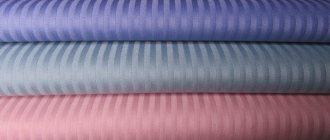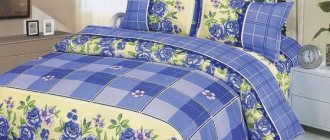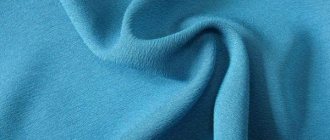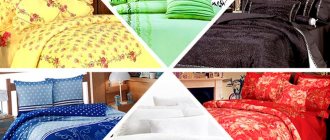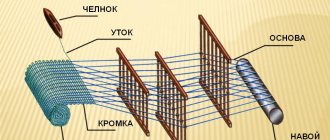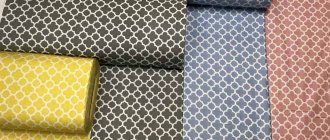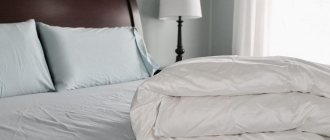Satin - what kind of fabric is it?
Satin is a fabric made from twisted cotton fibers of satin (satin) weave. Characteristic features of the material are a shiny front and matte back side. This effect is achieved thanks to weaving, in which several warp threads overlap one weft thread.
The minimum number of warp threads in one repeat is 4 pcs. The stronger the fibers are twisted, the greater the shine intensity of the fabric.
Photo: What satin looks like, close up
Fabric structure
Cotton sateen is a natural fabric, containing exclusively cotton fibers (100% cotton). But it is also divided into subspecies:
- Classic or regular satin;
- Satin jacquard;
- Stripe satin;
- Mako-satin;
- Coupon satin.
However, there are several more subtypes of mixed satin, including:
- Polysatin and sateen-double, which contain artificial and natural fibers;
- Crepe-satin and silk-satin are combined fabrics in which cotton is combined with artificial or natural silk.
Twill-satin belongs to a separate category, differing from satin in the processing of threads and weaving. To create it, untwisted threads and twill weaving are used, which makes the fabric less dense. The fabric itself can be either cotton or blended.
Quality
The characteristics of satin bed linen vary depending on the quality of the raw materials and components that make up the fabric.
The highest ratings go to bedding sets made from natural varieties of satin - they combine beauty and wear resistance, softness and wrinkle resistance, pleasant tactile sensations and hypoallergenicity.
The addition of synthetic threads to the composition does not affect the appearance of the product, but it affects the breathability of the fabric, its hygroscopicity, and can cause the formation of pilling during operation and the accumulation of static electricity. In some cases, mixed materials may cause skin reactions.
Satin and its varieties belong to the category of high-quality bed linen. A wide range of bedding sets of different quality and price parameters allows you to choose the optimal solution for each consumer.
general information
- Satin is the most popular material for sewing bed linen , made by complex weaving from two natural cotton threads - a thick one, from which the base is woven, and a thin (twisted type), which forms the face. Thanks to this special weaving, the front side of the fabric has a characteristic shine, while the back surface is matte. Due to its noble appearance, reminiscent of silk and having the quality of natural cotton, satin used to be called “cotton silk”.
- The strength of any fabric directly depends on the density of the weave of the threads during its manufacture. Satin has a high-class density - 110-180 threads per 1 sq. cm ; manufacturers of quality underwear indicate this characteristic on the underwear packaging.
- To add additional shine, the textile industry uses special technologies - mercerization or calendering , which increase the strength of satin bed linen fabric. As the product is used and the number of washes increases, the shine is slightly lost.
- The pattern of satin linen retains its freshness, richness of colors and clear outlines for a long time thanks to the technology of special processing of the fabric by fixing the paint . But it is not recommended to add bleach when washing.
- The washing temperature for satin linen is in the range of 40-600C , hot water will not damage the product, it will not deform or shrink.
Types of satin for bed linen
Not all varieties of satin are equally suitable for making bed linen. The most expensive and high-quality varieties of cotton sateen are:
- Coupon satin. The material is prepared individually for each set and each detail of the bedding set corresponds to a verified image size printed using the printing method.
- Mako-satin. The raw material used is selected Egyptian long-staple cotton, whose fibers are carefully combed and twisted. The linen made from it is soft, delicate, durable and smooth.
- Satin jacquard is unique in that the pattern on the material is created using the jacquard weaving method. The result is a double-sided fabric with an elegant pattern created by a combination of shiny and matte areas. The only difference between the sides is that on one side the pattern will be slightly convex, and on the other side it will be depressed.
- Stripe satin also has a double-sided pattern, but unlike jacquard floral motifs, it adheres to strict lines and consists of alternating shiny and matte stripes.
The most popular, due to the combination of high quality and affordable price, are the following types:
- Cotton satin. They are ideal for bedding, satisfying the physiological and aesthetic needs of consumers.
- Silk-satin is a material that contains natural silk along with cotton. The combination of different types of natural fibers creates an interesting effect: one side of the material is smooth, shiny and slippery, and the other is matte and non-slip.
The budget group includes bedding sets made from the following materials:
- Polysatin (novosatin) is a combination of cotton fibers and polyester.
- Crepe-satin - cotton fibers interspersed with artificial silk threads.
- Twill-satin - found both from natural raw materials and with the addition of synthetic fibers.
Most types of this material have found their application for sewing bed linen, with the exception of stretch options, which are more suitable for making clothes, and double satin, which is mainly used as a lining material.
Is satin bed linen really an option for high-quality and inexpensive material that will ensure a healthy and restful sleep? Read the article and you will learn about the wonderful properties of satin.
Satin bed linen from economical to luxury
Why is such close attention paid to the fabric from which bed linen is made? Yes, because its qualities affect sleep, mood and, as a result, overall well-being. And considering that a person spends about a third of his life in bed, the need for a careful approach to choice is understandable. Satin bedding is an option for high-quality and inexpensive material that will ensure a healthy and restful sleep.
Satin lingerie
An attractive material that has a shimmering shine, is dense, delicate, silky, bright and light - this is satin. The fabric is based on cotton, which gives it all its positive qualities:
• hygroscopicity; • hypoallergenic; • not expensive.
The composition of the fibers may vary depending on the addition of silk or synthetics to cotton. In appearance, satin is a material with a smooth, shiny, silky surface, which is why it can be confused with silk. The fabric is rough on the inside, which prevents the bed linen from slipping during sleep. Satin bed linen:
• soft as silk; • warm like cotton; • practically does not wrinkle; • not electrified; • hygroscopic; • allows air to pass through; • easy to use; • durable.
In terms of cost, satin occupies an intermediate position: it is more expensive than affordable cotton, but cheaper than expensive elite silk.
Satin and its varieties
The name of the fabric comes from the weaving method of the same name. It consists of a special interweaving of two threads:
• dense – basic; • twisted thin, forming the front part.
Depending on the weaving density, which is measured by the number of threads per square centimeter, several types of satin are distinguished. At the same time, they differ visually and in price of products made from them: Regular satin. It has a low density (85-130 threads/cm²). The most common material used for the production of bedding in the budget segment. Printed satin. The density of matter is already higher (about 170 threads/cm²). The material has a pattern that is obtained by interweaving dyed threads. At the same time, the pattern is not limited by space, and when cutting there is no need to specially select a pattern, which reduces the cost of the finished product. Satin coupon. It has the same density as printed material. It differs in the way the drawing is applied. An element of a pattern is applied to the finished fabric using printing, the motif of which is selected according to the future finished product (duvet cover, pillowcase). A wide variety of bedding sets are created from coupon sateen. Modern technologies have made it possible to introduce special reactive printing, which makes it possible to obtain patterns with a 3D effect. Bed sets with patterns made using this technique look very stylish, modern and impressive. Satin jacquard. Fabric with a density of 170 to 220 threads/cm². Jacquard patterns are woven from threads of two threads that match the color scheme. In this case, the fibers are woven so that each side of the material has its own shade, and the finished fabric does not have a front or back side. Jacquard fabric is light and soft, very wearable and practical, along with a sophisticated and attractive appearance. Satin-mako. Material with the highest density (at least 220 threads/cm²). In its production, the most expensive type of cotton is used, which forms a long, thin thread. Because of this, the cost of finished products made from this fabric is higher than others. The material is very smooth, with perfect shine, light and airy, along with strength. Can be painted in any shade. Bedding made of mako-satin practically does not wrinkle, so after washing you can do without ironing.
Advantages and disadvantages
The list of positive and negative qualities of satin is directly dependent on its composition. Among the advantages of fabrics made from natural cotton:
- Hypoallergenic. During the production process, raw materials undergo only safe processing methods and the finished products do not pose a risk to people with sensitive skin.
- Hygroscopicity. Cotton perfectly absorbs and removes excess moisture, maintaining a comfortable feeling in both hot and cool rooms.
- Breathability. One of the most important qualities of linen is ensuring air circulation.
- Strength and durability. The canvas is highly dense, durable and can last about 4-6 years with intensive use.
- Low thermal conductivity, thanks to which the fabric warms in a cool room and keeps pleasantly cool in a hot room.
- Aesthetics. The satin weave fabric looks advantageous due to the shine of the front side. The density and smoothness of the material makes it beautiful both bleached and dyed.
- A wide selection of patterns when using the jacquard technique, colors and designs when painting smooth surfaces.
- Low creasing. With proper drying, you can do without ironing.
- Minimum shrinkage of no more than 5%.
- Low maintenance requirements. It washes well at temperatures up to 40 degrees, without requiring specialized washing products. For spinning, 600-800 revolutions are enough.
The only disadvantage of cotton satin is the cost, and this will only apply to its individual types, such as jacquard, stripe, coupon and mako-satin.{banner_serefs}{banner_ondes}
Fabrics made from a combination of cotton and natural silk have almost all the advantages of cotton sateen, with the exception of some points:
- high price;
- more slippery front side;
- increased demands on product care.
Mixed fabrics are more affordable for buyers, do not wrinkle, have an excellent appearance, are strong and durable, but have several disadvantages:
- become electrified;
- become covered with pellets;
- have a lower degree of breathability and moisture absorption;
- may cause skin reactions.
Customer Reviews
Customer opinions depend on their demands on bed linen and experience with use.
Consumers who use natural types of satin are satisfied with everything about this fabric, including the cost, since it is completely justified and meets the quality of the product.
Moreover, it is not necessary to buy a luxury set made of jacquard or coupon sateen to appreciate all the advantages of cotton sateen.
Those who bought bedding sets made from mixed fabrics with the addition of synthetics had divided opinions. Some are satisfied with the quality, while others note such issues as the appearance of pilling, electrification and increased sweating due to the fact that the fabric “breathes” less well.
pros
The structure of satin is made of two types of natural cotton threads. The base is thicker, giving the material durability and strength. The face thread is twisted and thinner. It gives the fabric an elegant shimmer.
Bed linen set made of luxury mako-satin SO-8 (Stile Tex, Russia)
Those who know about all the advantages of the fabric decide to buy satin bed linen:
- wrinkles little, so it requires minimal ironing time, and the bed maintains a neat appearance for a long time;
- the front side has a beautiful shine, comparable to that of silk fabric;
- the back is matte, so unlike silk, satin does not slide off the mattress;
- perfectly regulates heat exchange, so sleeping under satin linen in winter is very comfortable;
- durable - can withstand at least 200 washes without changing color or geometry (if, of course, you choose a set from a good manufacturer).
A twisted thread is passed through every fourth purl, giving the material an elegant look. Calico, for example, has a simple weave of threads, so in appearance it is in many ways inferior to satin.
How to choose high-quality satin bed linen
In order for a bedding set to provide comfort while you sleep, you need to protect yourself from counterfeits and low-quality products:
- Check the composition - the higher the percentage of cotton, the better. If it is not indicated at all, the information on the sewn-in tag does not match the information on the packaging, or if it contains more than 50% synthetics, then such a product should not be purchased.
- Evaluate the quality of tailoring - there should be no crooked stitches or protruding threads.
- Pay attention to the smell - it should not be sharp or unpleasant. This smell indicates the use of cheap and low-quality dyes.
- Feel and try to stretch the fabric - it should not be loose or stretch too much.
- Weigh several proposed sets in your hands for comparison - natural satin weighs about twice as much as synthetic satin.
What density of satin is best for bed linen?
There are certain requirements for the material to be suitable for sewing bedding sets, and one of them is the density of the fabric. Linear density is determined by the number of threads per square centimeter, and surface density is measured in g/m2.
For different types of satin, the linear density is different and 1 cm2 contains:
- up to 130 threads for classic cotton sateen;
- up to 170 threads for coupon;
- up to 220 threads for fabric made using jacquard technique;
- over 220 threads for mako satin.
These figures correspond to a surface weight of 120 g/m2 for regular cotton or sateen blends and up to 220 g/m2 for premium material.
Synthetic satin
Synthetic, or as it is also called, artificial satin is often compared to silk. But unlike silk, it consists of chemical compounds - polyester or polyester.
Read more
Satin has a special type of weaving in which the base of the material consists of dense threads. And for the front side, thinner and more twisted threads are used. It is because the thread is twisted that satin gets its shine. The more the thread is twisted, the greater the shine.
The density of satin is quite high. Depending on the type of satin, one square centimeter of material requires from 85 to 200 threads.
Synthetic satin is pleasant to the touch. Basically, pastel linen is made from it. Due to its high density, products made from this fabric do not wear out for a very long time.
Which bedding is better: satin, poplin or calico
Comparing the different types of fabrics used for sewing bed linen will help you make a choice when it comes to purchasing the next set of bedding.
Calico
consists of 100% cotton without impurities. To create the fabric, plain weaving is used from fairly thick, untwisted fibers. Calico, compared to satin and poplin, seems rougher to the touch and looks looser, but its strength characteristics are not inferior to and even superior to these materials.
And although calico does not look so advantageous due to its rough texture and matte surface, it fully meets the basic requirements for good bed linen, such as: hygroscopicity, breathability, low thermal conductivity, durability and hypoallergenicity.
Another significant advantage of calico is that it has the most affordable price among other cotton fabrics.
Poplin
thinner than satin. Despite the plain weave, like calico, the type of fabric is different, since the warp and weft threads are different in thickness, which creates a characteristic scar on the fabric. Similarly, satin can be completely natural or mixed. Despite the fact that the fabric seems thinner, its density is comparable to satin and ranges from 110 to 145 g/m2. Cotton poplin wrinkles very little, is almost not subject to shrinkage and can serve for a long time without loss of quality and external characteristics.
Poplin, which contains silk, is more difficult to care for and a little slippery, which is reminiscent of the qualities of satin. And the combination with synthetic fibers leads to problems for all mixed fabrics, such as: electrification, the appearance of pilling and deterioration of the breathable and moisture-wicking properties of the fabric.
There is no clear leader among the compared fabrics, since each has its own characteristics that can attract a particular consumer.
A person spends a significant part of his life sleeping and the better he can take care of comfortable rest, the more strength and energy he will receive in return. Smooth pillowcases, cozy duvet covers, soft sheets are important components that ensure healthy sleep. Satin bedding sets are deservedly among the bestsellers, as they have these and other properties of high-quality bed linen.
What bed linen should I buy: satin or other cotton fabrics?
Satin or calico: firstly, these fabrics are completely different in price. Thus, bed linen made from calico is considered one of the cheapest, and from satin – expensive. Calico is less dense compared to satin and, accordingly, the service life of calico linen on your bed will be much shorter. So calico loses to satin in everything except price.
Satin or percale: percale, like satin, is a very dense fabric, and sometimes percale is even denser, and the denser the fabric, the longer the bed linen will last. However, percale lacks the shine that satin has and for which lovers choose. At the same time, percale is very pleasant and smooth to the touch. Its advantage is also that it does not allow down and feathers to pass through. If you now cannot choose, buy two sets of bed linen, and during use, decide which you like best.
Satin or ranfors: ranfors has been known not so long ago; its other name is improved calico. This fabric is denser than calico, smooth and of high quality, thanks to which it can withstand a large number of washes. Ranfors has a shine, although, of course, not the same as satin, since it is mercerized. You should choose between satin and ranfors, as when choosing percale, based on your own preferences. Let us only note that it is believed that ranfors is capable of warming well in winter and cooling a little in summer.
